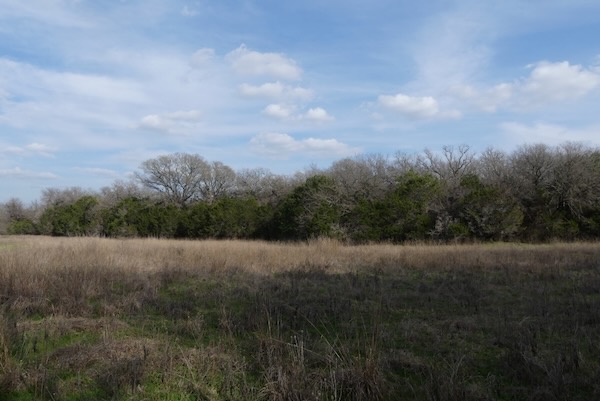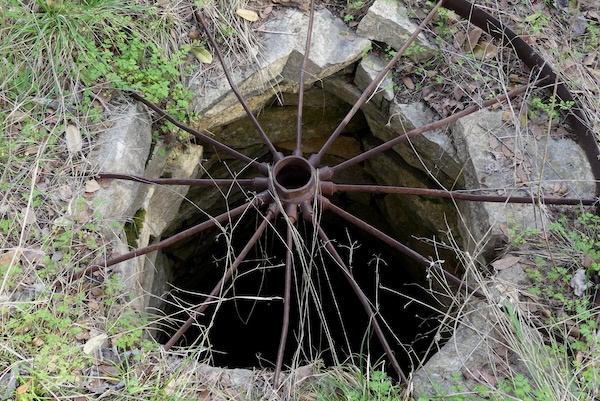
The Brazos River flows through the northern border of the Little L Ranch. Photo by Michael Smith.
March 21, 2024
Perhaps you’ve gotten one in the mail — a colorful postcard offering real estate opportunities “out in the country,” where you can breathe fresh air on your little ranchette.
The untold back story is that time ran out for someone’s ranch. Age or economics or other circumstances made it unworkable for the owners to continue. The land and all the habitat and wildlife living there is sold — chopped up into small parcels, requiring new roads and amenities.
Or maybe, if the land is near the city, it is sold to a developer who puts up row after row of new houses and convenience stores.
As I drove out to see the Little L Ranch, I passed miles of new development at the southwest edge of Fort Worth . The prairie soil, now bulldozed into an expanse of gray-brown dirt, was dotted with skeletal frames that will be finished out into houses, one after another.
Fortunately, I was on my way to see a place that will not be scraped and populated with homes. Instead, thanks to a ranching family’s foresight and wisdom, a land trust will ensure their 624 acres along the Brazos River remains intact.
The tool that will accomplish this is a conservation easement, a legally binding agreement in which the owners keep their land and agree to protect it.
RIVER FRONT PROPERTY
A view of the Brazos River from a corner of the Little L Ranch. Photo by Michael Smith.
The Little L Ranch is nestled along one of the bends of the Brazos River, southwest of Cleburne in Bosque and Somervell Counties. Owner Bob Walker recalled that the expansive riverfront was what attracted his wife's parents, Dr. John G. Little, a medical doctor returning to his medical practice in Cleburne after World War II, along with his wife Dorothy, when they bought the property in 1947.
Bob said the doctor was rarely at the ranch and it was Dorothy who managed the livestock and fences. She experimented with crops, from peanuts to pecans, and raised goats and cattle.
After the passing of the couple, Bob and his wife Sherry wanted to keep the savannahs and woodlands of the ranch intact. The family sold all the cattle in 2017 and focused on restoring the native prairies and enhancing wildlife habitat.
A certified Texas Master Naturalist, Walker led the conservation efforts and is active in the annual Brazos River Cleanup. The ranch itself is a sort of headquarters for the yearly effort to remove old tires and litter from the river, as can be seen in the video below..
The Rio Brazos Chapter of Texas Master Naturalists won a state-wide award in 2023 for the Sixth Annual Brazos River Cleanup. More than 60 volunteers removed 143 tires and several bags of trash from 17 miles of river. Courtesy of the Rio Brazos Chapter.
Bob and Sherry have had many conversations about protecting the ranch into perpetuity.
“Although our kids love it, someone down the line would sell it off,” he said.
They learned about a legal tool with which landowners can conserve their land and continue their ownership. Conservation easements include tax advantages that can make it more economically feasible to keep a ranch intact.
PERMANENTLY PROTECTED
I spoke with Stephen Ramirez, conservation director for the Texas Land Conservancy. He agreed that the sale of private lands for development is a major threat to North Texas nature.
“Across the landscape, it’s becoming death by a thousand cuts,” he said.
A landowner can make considerably more by selling a property to developers than they could make from a buyer with plans for agricultural uses.
Ramirez told me that a conservation easement is a legally binding agreement between the landowner and a land trust like TLC.
“It’s a tool that will permanently restrict the amount and types of uses on a piece of land in order to protect its significant conservation resources,” he said.
The agreement might limit the building of structures or roads, or specify that certain areas with valuable habitat cannot be destroyed.
He describes these limits as “guardrails” that help keep the land on a conservation path while letting landowners keep using and enjoying their property.
He tells landowners, “We want you to be able to continue doing the things you’ve been doing.”
HOW DOES IT WORK?

A patch of prairie on the ranch with purple top tridens as one of the main grasses. Photo by Michael Smith.
There are a couple of variations, but typically, the conservation easement process starts with an appraisal of the land’s fair market value — an estimate of the most likely value the property would sell for. Then the appraiser looks at how much the land would be worth with the easement’s restrictions in place. The difference between those two values is how much the easement is worth. That determines the value of tax deductions the landowner would receive under the conservation easement.
When both parties — the owner and the land trust — agree to get started, the land trust does a deeper evaluation of the property. They look at the land and soil, the water features (for example, the condition and ecological significance of streams or rivers), and the plants and wildlife. The cost of such evaluations and the due diligence to ensure a sound transaction may be borne by the owner or there may be grant funds that can cover at least part of the cost.
The Protect Your Land page on the TLC website contains more detailed information about how conservation easements work.
After the easement is in place, there is ongoing monitoring by the land trust. TLC does an annual site visit to tour the property and get updated information, as well as talk about any future plans the landowner has.
MAKING THE DECISION

A sign on the gate announces the Little L Ranch includes certified wildlife habitat and is protected by the Texas Land Conservancy. Photo by Michael Smith.
Walker talked with me about their decision-making process. He recalled that Amber Arseneaux, now the executive director of the Native Prairies Association of Texas, gave a presentation about conservation easements at a Master Naturalist chapter meeting. At the time, Arseneaux was the North Texas program director for the Texas Land Conservancy.
Inspired by her presentation, he discussed the land trust with his wife. They concluded, “Let’s do this.” The entire 624-acre property was placed into the easement.
Bob and Sherry specified that a small percentage of the property could be used to build some cabins and meeting space.
“We feel very fortunate to have this land, and we feel that we need to share it, but we don’t want to turn it into a public park,” he said.
They want to share it with groups that have the similar values and goals, and they would like to “open it up to colleges for research.” Additionally, a few cabins that could be rented online could be “the profit side that would sustain the nonprofit side.” Walker imagines renting to folks like photographers and ornithologists.
QUIET SPOT
We sat on the stone porch of the ranch house. For me, it was a treasured opportunity to hear breezes and birds with no highway noise or other mechanical sounds. Walker said he notices this quiet every time he steps onto the porch.
 Bob Walker gives a tour of Little L Ranch. Photo by Michael Smith.
Bob Walker gives a tour of Little L Ranch. Photo by Michael Smith.
“This is my favorite place to sit in the morning with a cup of coffee,” he said.
And at night, the skies are truly dark.
He showed me the various habitats on the property, from the river and its nearby floodplain to a hay meadow, woodlands and patches of prairie. The only cattle on the property are the neighbor’s cows, periodically allowed in so that the grasslands get the benefits of grazing.
An upland area contains some thick stands of Ashe juniper that were choking out what would, at an earlier time, have been post oak savannah. Walker hired a company that uses equipment to mulch some of the junipers down, exposing some very big post oaks. In other areas, he is leaving the juniper woodlands just as they are.
He advocates for conservation easements with his neighbors.
“Most of them I talk to say, ‘I don’t want to give my land to the government or to corporations,’ but that’s not what happens.”
Perhaps he can help others to better understand it, and if so, everyone benefits. If you are the only one with a conservation easement, what if the land around you is sold off and developed? No one wants to be an island of conservation in a sea of sprawl.
Texas is a state in which about 95 percent of the land is privately owned. This makes it all the more important to have tools that help landowners be conservationists.
“Private landowners are the caretakers of our state," Ramirez said. "It’s a wonderful state with so many treasures.”
If you are interested in establishing a conservation easement on your property with TLC, you may be interested in the North Texas Landowner Workshop on April 23.
 An old well covered by an old wagon wheel on the property. Photo by Michael Smith.
An old well covered by an old wagon wheel on the property. Photo by Michael Smith.
North Texas Landowners Workshop
Hosted by: Texas Land Conservancy
About: Landowners with interest in protecting their own properties through conservation easements can learn about the process of protecting your land for future generations. Panel discussion with representatives from Western Landowners Alliance, Texas Agricultural Land Trust, Texas Land Conservancy, The Nature Conservancy, Living Lands Trust and Native Prairies Association of Texas. A barbeque lunch will be provided.
When: April 23, 2024, 10 a.m. to 4 p.m.
Where: Fall Creek Ranch, 8220 Langdon Leake Court, Granbury
RSVP: On website link below.
RELATED ARTICLES
Austin-based land trust acquires Connemara's holdings
Former Boy Scout camp shelters nature in urban Dallas
Land trusts aim to preserve Texas landscape
Stay up to date on everything green in North Texas, including the latest news and events! Sign up for the weekly Green Source DFW Newsletter! Follow us on Facebook, X and Instagram. Also check out our new podcast The Texas Green Report, available on your favorite podcast app.









